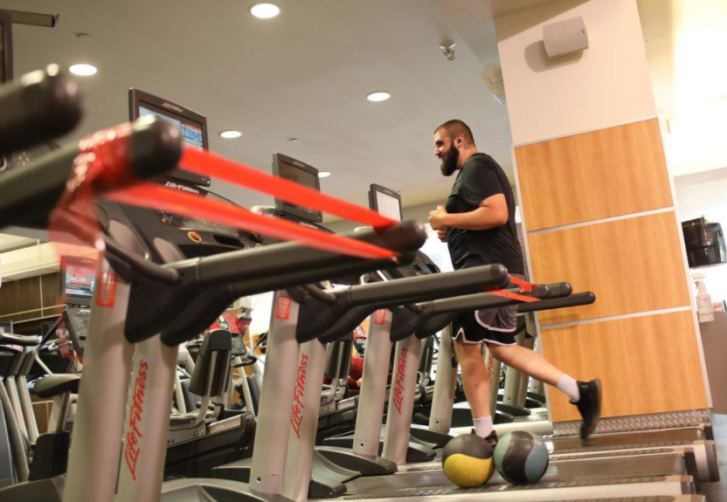After more than a year and a half of lockdown cycles, all eyes are on the further easing of COVID-19 restrictions in Ontario with the news that a road map for lifting capacity limits on venues like gyms, restaurants and bars is coming this week.
But experts urge caution for this crucial next step, stressing that as much as we might like to be, we’re not totally out of the woods yet.
“The secret now is to realize that even though there is no snow coming yet, we shouldn’t throw away our snowshoes,” said Dr. Peter Jüni, a professor of epidemiology at the University of Toronto’s Dalla Lana School of Public Health and scientific director of the Ontario COVID-19 Science Advisory Table.
“This next step is a challenge. Why? Because this disease is predominately airborne in transmission.”

Facing anger from small business owners that capacity limits were lifted for movie theatres, concert halls, sports stadiums and other large venues before Thanksgiving, Premier Doug Ford said at a Friday press conference that a “comprehensive plan” will be coming this week to “cautiously lift more public health measures.”
Jüni said it will be key to wait at least two to three weeks before lifting capacity restrictions on venues like bars, gyms and restaurants, to see the impact from easing limits on bigger venues, as well as Thanksgiving weekend gatherings.
“This is an experiment,” he said, and the province needs to see the result of one step before moving on to the next. “That’s why we do it so well compared with Saskatchewan and Alberta.”

There’s a “massive difference” in risk, he added, between a “well-ventilated large space” like a stadium and “a small intimate restaurant with low ceilings.” Indoor spots where people take masks off, particularly those with poor ventilation, have been tied to outbreaks around the world. Some of this North American evidence is laid out in a fall 2020 Science Table brief.
Further reopening past Phase 3 was delayed in the summer as the Delta variant caused a surge in cases. But since then, millions of people in Ontario have been vaccinated — 87.3 of the eligible population with a first dose and 82.8 per cent with both, as of Friday morning.
New daily cases, which are hovering around 400 to 600 per day are higher than in July when they dropped to under 200 but they appear to be plateauing, according to government figures, and the per cent of positive cases is at 1.4. As of Friday, there were 165 adults with COVID in the ICU and 104 ventilated, according to Critical Care Services Ontario.
“Personally, I’m walking on eggshells,” said Dr. Isaac Bogoch, an associate professor at the University of Toronto and a former member of the province’s now disbanded vaccine task force. But “the nuance is if you take a snapshot of where we’re at right now in Ontario, we’re doing OK,” he added. “It’s not perfect, but it’s also not terrible.”
Colin Furness, an assistant professor of epidemiology at U of T believes that “overall, it’s time to start opening up.”
But “we must not take all the brakes off, go whole hog,” he added, until kids under 12 get vaccinated and everyone over 65 can get a booster shot.

There are a number of things that could help keep the situation under control in the meantime, including beefing up contact tracing and introducing air quality standards and free HEPA filters for small venues like restaurants and gyms.
Bogoch praises Ontario’s “very slow, cautious and methodical approach to reopening” so far, coupled with high vaccine uptake and keeping other public health measures in place, such as mask requirements.
However, it’s “only October” and “there’s a lot of fall and winter ahead of us,” he said. There are also “thousands and thousands of people” over 50 who are still unvaccinated, and limited health care and ICU capacity.
The most important thing, Bogoch stressed, is that “if things aren’t going right, change course and change course quickly,” well before hospitalizations and ICU beds become a problem.
“Communicate that there might be peaks and valleys of COVID-19 throughout the fall and the winter, that this is not a one-way path toward reopening, that there might be some give and take and some of this may need to be scaled back,” he added.
Although details are still to be released, Ford told reporters Friday that while his “heart breaks” for small businesses, he’s “not going to rush it” on further reopening and doesn’t want to have to go backwards.
The plan will include “where and when” to “reapply measures, should they be required to stop a surge in transmission,” he said.
Dr. Kieran Moore, Ontario’s chief medical officer of health, said at a recent press conference that he needs to first see if there was a Thanksgiving bump in COVID cases, and hopes to then make a recommendation to the government on capacity in venues such as restaurants and gyms.
“We will not be doing this suddenly, this will be slow, gradual and cautious, following the data,” he said.
Omar Khan, an assistant professor at the University of Toronto Institute of Biomedical Engineering, said the “critical milestone” will be Health Canada’s approval of the vaccine for kids aged five to 11, which hopefully should be coming soon.
At the same time, making sure that people around the world have access to vaccines is critical, otherwise new variants could develop and quickly spread across borders.
“Globally, that will prevent another surprise like we saw with Delta,” he said.
Author: May Warren
Article From: The Star

